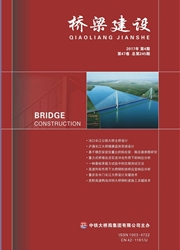

 中文摘要:
中文摘要:
因三塔悬索桥的中塔缺乏有效的纵向约束而对风作用敏感,为了深入研究三塔悬索桥静风失稳机理,以马鞍山长江公路大桥为背景,从应变能的角度分析该桥静风失稳形态.通过计算获得0°和3°初攻角下主缆、吊杆、主梁和桥塔等构件的应变能,并对比主梁和桥塔在失稳前、后各自由度应变能.结果表明:低风速下该桥相邻跨的位移呈相同的变化趋势,但在静风失稳临界风速下,邻跨位移出现了“分岔”现象,其静风失稳形态表现为反对称扭转与反对称竖弯的耦合;总应变能的变化规律由主缆主导,并且和初攻角有关;桥塔应变能增长主要由纵向弯曲引起;主梁应变能在侧弯、竖弯和扭转3个自由度上的分配比例关系反映了失稳后的弯扭耦合程度.
 英文摘要:
英文摘要:
A three-tower suspension bridge is sensitive to wind action due to the lack of effective longitudinal restraint at its central tower.To conduct a deep-going study of the aerostatic instability mechanism of the three tower suspension bridge,Maanshan Changjiang River Expressway Bridge was taken an example and the aerostatic instability mode of the example bridge was analyzed from the point of strain energy.Through the calculation,the strain energy of the components of the bridge,such as the main cables,suspenders,main girder and towers,under the initial wind attack angles of 0° and 3° was acquired.The strain energy of each freedom degree of the main girder and towers before and after the instability of the girder and towers were then compared in detail respectively.The results demonstrate that the displacement of the adjacent spans of the bridge at low wind speed presents the same changing tendency,but ‘forks’ on the adjacent spans at the critical wind speed of the aerostatic instability and the aerostatic instability mode of the spans manifests itself as the anti-symmetry torsion coupled with the anti-symmetry vertical bending.The changing law of the total strain energy is dominated by the main cables and is related to the initial wind attack angles.The growth of the strain energy of the towers is mainly caused by the longitudinal bending.The distribution ratio relationship of the strain energy of the main girder at 3 degrees of freedom of the lateral bending,vertical bending and torsion reflects the degree of bending-torsion coupling after the instability takes place.
 同期刊论文项目
同期刊论文项目
 同项目期刊论文
同项目期刊论文
 期刊信息
期刊信息
